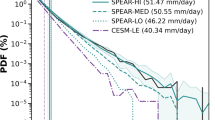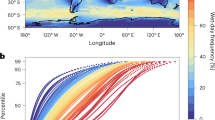Abstract
Intensification of the hydrological cycle is expected to accompany a warming climate1,2. It has been suggested that changes in the spatial distribution of precipitation will amplify differences between dry and wet regions3,4, but this has been disputed for changes over land5,6,7,8. Furthermore, precipitation changes may differ not only between regions but also between different aspects of precipitation, such as totals and extremes. Here we investigate changes in these two aspects in the world’s dry and wet regions using observations and global climate models. Despite uncertainties in total precipitation changes, extreme daily precipitation averaged over both dry and wet regimes shows robust increases in both observations and climate models over the past six decades. Climate projections for the rest of the century show continued intensification of daily precipitation extremes. Increases in total and extreme precipitation in dry regions are linearly related to the model-specific global temperature change, so that the spread in projected global warming partly explains the spread in precipitation intensification in these regions by the late twenty-first century. This intensification has implications for the risk of flooding as the climate warms, particularly for the world’s dry regions.
This is a preview of subscription content, access via your institution
Access options
Subscribe to this journal
Receive 12 print issues and online access
$209.00 per year
only $17.42 per issue
Buy this article
- Purchase on Springer Link
- Instant access to full article PDF
Prices may be subject to local taxes which are calculated during checkout




Similar content being viewed by others
Change history
01 February 2017
This Letter has an addendum associated with it, for details see pdf.
References
Allen, M. R. & Ingram, W. J. Constraints on future changes in climate and the hydrologic cycle. Nature 419, 224–232 (2002).
Wu, P., Christidis, N. & Stott, P. Anthropogenic impact on Earth’s hydrological cycle. Nature Clim. Change 3, 807–810 (2013).
Held, I. M. & Soden, B. J. Robust responses of the hydrological cycle to global warming. J. Clim. 19, 5686–5699 (2006).
Allan, R. P., Soden, B. J., John, V. O., Ingram, W. & Good, P. Current changes in tropical precipitation. Environ. Res. Lett. 5, 025205 (2010).
Sun, F., Roderick, M. L. & Farquhar, G. D. Changes in the variability of global land precipitation. Geophys. Res. Lett. 39, L19402 (2012).
Greve, P. et al. Global assessment of trends in wetting and drying over land. Nature Geosci. 7, 716–721 (2014).
Roderick, M. L., Sun, F., Lim, W. H. & Farquhar, G. D. A general framework for understanding the response of the water cycle to global warming over land and ocean. Hydrol. Earth Syst. Sci. 18, 1575–1589 (2014).
Byrne, M. P. & O’Gorman, P. A. The response of precipitation minus evapotranspiration to climate warming: why the ‘wet-get-wetter, dry-get-drier’ scaling does not hold over land. J. Clim. 28, 8078–8092 (2015).
Trenberth, K. E. Changes in precipitation with climate change. Clim. Res. 47, 123–138 (2011).
Alexander, L. V. et al. Global observed changes in daily climate extremes of temperature and precipitation. J. Geophys. Res. 111, D05109 (2006).
Min, S-K., Zhang, X., Zwiers, F. W. & Hegerl, G. C. Human contribution to more-intense precipitation extremes. Nature 470, 378–381 (2011).
Westra, S., Alexander, L. V. & Zwiers, F. W. Global increasing trends in annual maximum daily precipitation. J. Clim. 26, 3904–3918 (2013).
Sillmann, J., Kharin, V. V., Zwiers, F. W., Zhang, X. & Bronaugh, D. Climate extremes indices in the CMIP5 multimodel ensemble: part 2. Future climate projections. J. Geophys. Res. 118, 2473–2493 (2013).
Kharin, V. V., Zwiers, F. W., Zhang, X. & Wehner, M. Changes in temperature and precipitation extremes in the CMIP5 ensemble. Clim. Change 119, 345–357 (2013).
Donat, M. G. et al. Updated analyses of temperature and precipitation extreme indices since the beginning of the twentieth century: the HadEX2 dataset. J. Geophys. Res. 118, 2098–2118 (2013).
Durack, P. J., Wijffels, S. E. & Matear, R. J. Ocean salinities reveal strong global water cycle intensification during 1950 to 2000. Science 336, 455–458 (2012).
Chadwick, R., Boutle, I. & Martin, G. Spatial patterns of precipitation change in CMIP5: why the rich do not get richer in the tropics. J. Clim. 26, 3803–3822 (2013).
Trenberth, K. E., Dai, A., Rasmussen, R. M. & Parsons, D. B. The changing character of precipitation. Bull. Am. Meteorol. Soc. 84, 1205–1217 (2003).
O’Gorman, P. A. & Schneider, T. The physical basis for increases in precipitation extremes in simulations of 21st-century climate change. Proc. Natl Acad. Sci. USA 106, 14773–14777 (2009).
Westra, S. et al. Future changes to the intensity and frequency of short-duration extreme rainfall. Rev. Geophys. 52, 522–555 (2014).
O’Gorman, P. A. Sensitivity of tropical precipitation extremes to climate change. Nature Geosci. 5, 697–700 (2012).
Wilcox, E. M. & Donner, L. J. The frequency of extreme rain events in satellite rain-rate estimates and an atmospheric general circulation model. J. Clim. 20, 53–69 (2007).
Groisman, P. Y. et al. Trends in intense precipitation in the climate record. J. Clim. 18, 1326–1350 (2005).
Fischer, E. M., Beyerle, U. & Knutti, R. Robust spatially aggregated projections of climate extremes. Nature Clim. Change 3, 1033–1038 (2013).
Lenderink, G. & van Meijgaard, E. Increase in hourly precipitation extremes beyond expectations from temperature changes. Nature Geosci. 1, 511–514 (2008).
Allan, R. P. & Soden, B. J. Atmospheric warming and the amplification of precipitation extremes. Science 321, 1481–1484 (2008).
Zhang, X. et al. Detection of human influence on twentieth-century precipitation trends. Nature 448, 461–465 (2007).
Liu, C. & Allan, R. P. Observed and simulated precipitation responses in wet and dry regions 1850–2100. Environ. Res. Lett. 8, 034002 (2013).
Taylor, K. E., Stouffer, R. J. & Meehl, G. A. An overview of CMIP5 and the experiment design. Bull. Am. Meteorol. Soc. 93, 485–498 (2012).
Collins, M. et al. Climate Change 2013: The Physical Science Basis (IPCC, Cambridge Univ. Press, 2013).
Lambert, F. H. & Webb, M. J. Dependency of global mean precipitation on surface temperature. Geophys. Res. Lett. 35, L16706 (2008).
Zhang, X., Wan, H., Zwiers, F. W., Hegerl, G. C. & Min, S.-K. Attributing intensification of precipitation extremes to human influence. Geophys. Res. Lett. 40, 5252–5257 (2013).
Stephens, G. L. et al. Dreary state of precipitation in global models. J. Geophys. Res. 115, D24211 (2010).
Zhang, X. et al. Indices for monitoring changes in extremes based on daily temperature and precipitation data. Wiley Interdiscip. Rev. Clim. Change 2, 851–870 (2011).
Avila, F. B. et al. Systematic investigation of gridding-related scaling effects on annual statistics of daily temperature and precipitation maxima: a case study for south-east Australia. Weath. Clim. Extremes 9, 6–16 (2015).
Sillmann, J., Kharin, V. V., Zhang, X., Zwiers, F. W. & Bronaugh, D. Climate extremes indices in the CMIP5 multimodel ensemble: part 1. Model evaluation in the present climate. J. Geophys. Res. 118, 1716–1733 (2013).
Sen, P. K. Estimates of the regression coefficient based on Kendall’s Tau. J. Am. Stat. Assoc. 63, 1379–1389 (1968).
Kendall, M. K. Rank Correlation Methods (Charles Griffin, 1975).
Acknowledgements
This study was supported through the Australian Research Council grants CE110001028 and DE150100456. We thank the climate modelling groups contributing to CMIP5 for producing and making available their model output.
Author information
Authors and Affiliations
Contributions
M.G.D. conceived the study; A.L.L., M.G.D. and N.M. performed the analyses. All authors discussed the results and contributed to writing the manuscript.
Corresponding author
Ethics declarations
Competing interests
The authors declare no competing financial interests.
Supplementary information
Supplementary Information
Supplementary Information (PDF 3570 kb)
Rights and permissions
About this article
Cite this article
Donat, M., Lowry, A., Alexander, L. et al. More extreme precipitation in the world’s dry and wet regions. Nature Clim Change 6, 508–513 (2016). https://doi.org/10.1038/nclimate2941
Received:
Accepted:
Published:
Issue Date:
DOI: https://doi.org/10.1038/nclimate2941
This article is cited by
-
Significantly wetter or drier future conditions for one to two thirds of the world’s population
Nature Communications (2024)
-
Evolutionary analysis of rainstorm momentum and non-stationary variating patterns in response to climatic changes across diverse terrains
Scientific Reports (2024)
-
Climate, desertification, and local human development: evidence from 1564 regions around the world
The Annals of Regional Science (2024)
-
Spatial–temporal evolution characteristics and influence factors of extreme precipitation indices based on bias-corrected and gauge-measured precipitation data in the main river basins of China, 1980–2020
Theoretical and Applied Climatology (2024)
-
Analysis of extreme rainfall and landslides in the metropolitan region of the Paraiba do Sul River Valley and North Coast of Sao Paulo, Brazil
Theoretical and Applied Climatology (2024)



